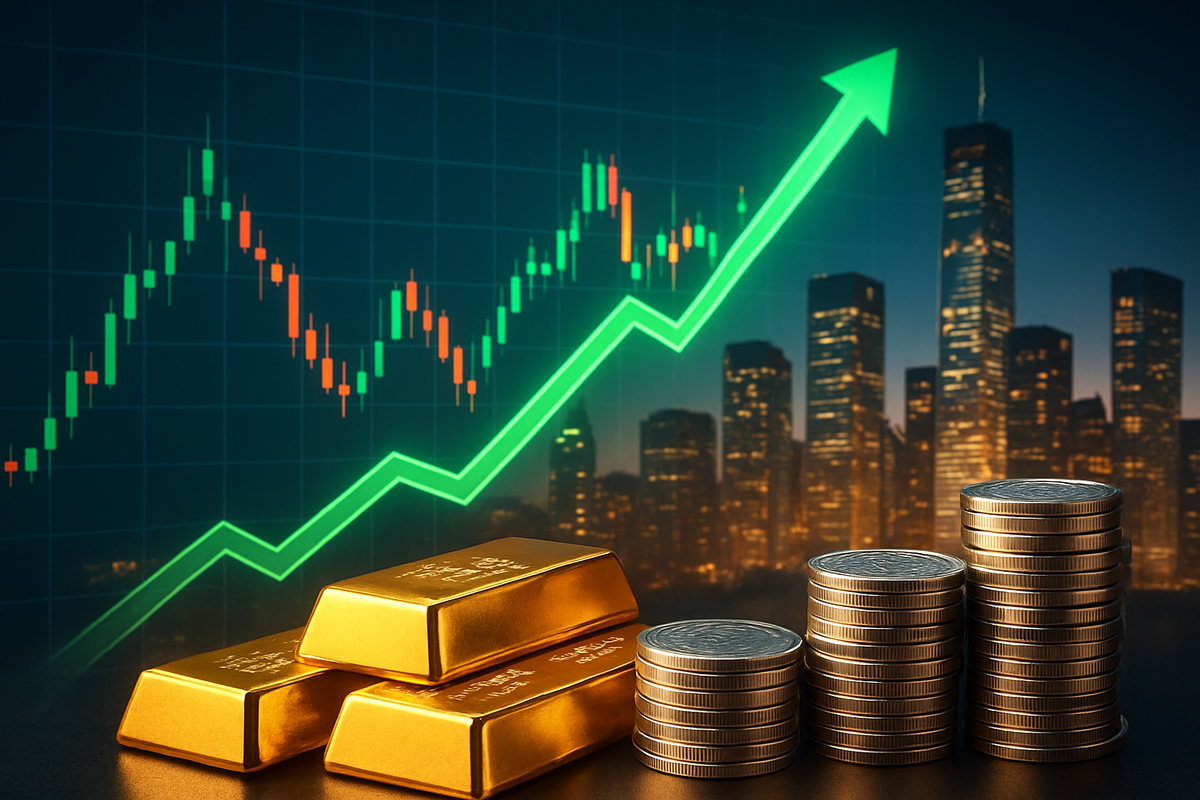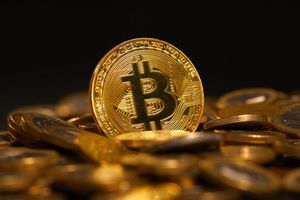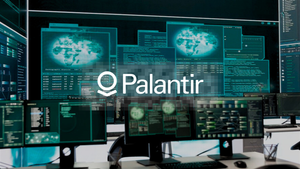
New York, NY – November 12, 2025 – In a remarkable display of market resilience and underlying tension, the Dow Jones Industrial Average (DJIA) has surged past the 48,000-point threshold, closing at an unprecedented 48,015.79. This historic equity rally is unfolding concurrently with a robust ascent in precious metals, with gold briefly surpassing $4,100 per ounce and silver peaking above $51 per ounce. This dual phenomenon paints a picture of a financial landscape marked by both cautious optimism for economic growth and persistent anxieties over inflation and geopolitical instability, prompting investors to seek both aggressive growth and traditional safe havens.
The simultaneous rise in seemingly disparate asset classes signals a complex market sentiment where participants are hedging their bets amidst a volatile global environment. While strong corporate earnings and expectations of further dovish moves from the Federal Reserve are fueling equity enthusiasm, the powerful rally in gold and silver underscores deep-seated concerns about currency debasement, geopolitical risks, and the long-term economic outlook. This delicate balance suggests a market navigating a "tug-of-war between short-term political relief and deep-seated economic anxieties," as analysts grapple with the sustainability of such divergent trends.
Unpacking the Dual Ascent: A Closer Look at Market Drivers
The Dow's monumental climb to 48,015.79 on November 12, 2025, was immediately propelled by renewed optimism surrounding a potential resolution to the prolonged US government shutdown, which had cast a shadow over recent weeks. Leading the charge were strong performances within the healthcare sector, with industry giants such as Merck & Co. (NYSE: MRK), Amgen Inc. (NASDAQ: AMGN), and Johnson & Johnson (NYSE: JNJ) demonstrating significant gains and contributing substantially to the index's upward momentum. This sector-specific strength, coupled with broader economic resilience, has provided a solid foundation for the equity market's sustained rally.
Beyond immediate catalysts, the broader narrative supporting the Dow's ascent includes a resilient US economy that has defied earlier recessionary predictions, showing robust GDP growth. The Federal Reserve's anticipated rate cuts, with at least two expected in 2025 following a 25-basis point reduction in October to a benchmark of 3.75%-4%, have also served as a significant tailwind for stocks, making borrowing cheaper and equities more attractive. Furthermore, robust corporate earnings, with S&P 500 components reporting approximately 8% year-over-year earnings growth in Q3 2025, particularly fueled by advancements in artificial intelligence (AI), have provided fundamental support. A cooling inflation narrative, coupled with sustained consumer spending, has also bolstered investor confidence, while a persistent "buy-the-dip" mentality has ensured rapid rebounds from market pullbacks.
Concurrently, the unprecedented rally in gold and silver to record highs reflects a confluence of factors driven by global uncertainties and a flight to safety. Persistent inflation, with the US Consumer Price Index (CPI) accelerating to 2.9% annually in September 2025, has underscored the role of precious metals as a hedge against currency debasement. Falling real interest rates and expectations of further Fed rate cuts in December 2025 make non-yielding assets more appealing. Geopolitical tensions, including renewed trade conflicts, military flashpoints, and policy fragmentation, have intensified safe-haven demand. The prolonged US government shutdown also fueled concerns about the broader economic outlook, driving capital into precious metals. A weakening US dollar index has made gold cheaper for international buyers, while continued significant net buying by central banks and increased institutional interest further cement gold and silver's status as crucial hedges in an uncertain world.
Initial market reactions from financial analysts highlight the complexity of the current environment. While acknowledging the market's resilience, many express caution regarding the sustainability of the equity surge, especially given elevated valuations. Some analysts, like those at 5i Research Inc., view strong earnings and rate cuts as solid foundations, while others voice concerns about potential "bubble issues" in AI stocks, though generally not predicting an immediate crash. The concurrent rally in stocks and precious metals is widely interpreted as investors strategically hedging their portfolios, seeking both growth opportunities and protection against potential downside risks such as persistent inflation or geopolitical shocks. This unusual dynamic points to a prevalent "risk-off sentiment" coexisting with bullish equity bets, reflecting a desire for capital preservation amidst future uncertainties.
Corporate Fortunes: Winners and Losers in a Dual-Rally Market
The current market environment, characterized by both a surging Dow and a strong rally in precious metals, presents a mixed bag of opportunities and challenges for public companies. Companies poised to benefit significantly are those within sectors driving the Dow's growth, particularly healthcare and technology, especially those with strong AI exposure. Large-cap pharmaceutical companies like Merck & Co. (NYSE: MRK), Amgen Inc. (NASDAQ: AMGN), and Johnson & Johnson (NYSE: JNJ), which were highlighted as leaders in the recent Dow surge, are likely to continue seeing investor interest due to their defensive characteristics, robust pipelines, and consistent earnings. Technology companies, particularly those innovating in artificial intelligence, such as NVIDIA Corporation (NASDAQ: NVDA) or Microsoft Corporation (NASDAQ: MSFT), are expected to maintain strong investor confidence, albeit with an eye on valuation concerns. Their strong earnings growth and pivotal role in technological advancement position them favorably.
On the other hand, the rally in gold and silver directly benefits mining companies and precious metal streamers. Companies like Barrick Gold Corporation (NYSE: GOLD), Newmont Corporation (NYSE: NEM), and Agnico Eagle Mines Limited (NYSE: AEM) will likely see increased revenue and profitability due to higher commodity prices, potentially leading to expanded exploration budgets and improved shareholder returns. Silver miners such as Pan American Silver Corp. (NASDAQ: PAAS) and Wheaton Precious Metals Corp. (NYSE: WPM) are also direct beneficiaries, as higher silver prices boost their margins. Furthermore, companies involved in the production of industrial components using silver may face increased input costs but could also benefit from renewed industrial demand if the underlying economic strength persists.
However, certain sectors and companies might face headwinds. Businesses heavily reliant on consumer discretionary spending could experience pressure if the underlying economic anxieties that drive precious metal demand lead to a slowdown in consumer confidence, despite current strong spending. Companies with high debt loads might also find themselves in a precarious position if interest rates, despite recent cuts, remain elevated compared to historical lows, increasing their debt servicing costs. Furthermore, companies in sectors prone to geopolitical risks or those with significant international exposure might face increased volatility and operational challenges as global trade conflicts and policy fragmentation persist, potentially impacting their supply chains and market access.
The overall impact on companies will largely depend on their ability to adapt to this bifurcated market. Those with strong balance sheets, diversified revenue streams, and a clear strategy to navigate both growth opportunities and risk mitigation will likely thrive. Companies that are heavily exposed to specific risks, such as unhedged commodity price fluctuations (for non-mining companies) or overly aggressive growth strategies without sufficient risk assessment, could face challenges. The market's current complexity demands agility and strategic foresight from corporate leadership.
Wider Significance: Navigating a Market of Contradictions
The simultaneous surge of the Dow Jones Industrial Average past 48,000 points and the robust rally in gold and silver prices reflects a profound and complex shift in broader industry trends, signaling a market grappling with both fervent optimism and deep-seated anxieties. The Dow's ascent underscores a sustained bullish momentum in the U.S. economy, largely fueled by strong corporate earnings and investor confidence in traditional sectors. A notable trend observed is a "rotation from growth to value stocks," with the Dow outperforming the tech-heavy Nasdaq, indicating a maturing market cycle where profitability and stability in sectors like financials, industrials, and healthcare are gaining precedence over speculative growth. However, this optimism is tempered by growing concerns over "lofty valuations in the heavyweight tech sector" and fears of an "AI-driven market bubble," even as leading AI companies like NVIDIA Corporation (NASDAQ: NVDA) continue to see immense demand, creating opportunities for partners in chip manufacturing, cloud services, and software development.
The parallel rally in gold and silver, with gold surpassing $4,100 and silver over $51 per ounce, highlights persistent concerns about inflation, currency debasement, and pervasive global uncertainty. These precious metals are serving as critical hedges against the erosion of fiat currency value, a sentiment reminiscent of past inflationary periods. Beyond its safe-haven appeal, silver is also benefiting from strong industrial demand, particularly in burgeoning green technologies like solar panels and advanced electronics. This dual dynamic creates ripple effects across the economy. While the strong equity market provides increased visibility and potentially lower costs of capital for Dow-listed companies, businesses reliant on discretionary consumer spending could face headwinds if underlying economic anxieties lead to contraction. High commodity prices, including precious metals, can also increase production costs across various sectors, from manufacturing to transportation, impacting corporate margins and potentially leading to higher consumer prices. A potential "AI bubble" correction, meanwhile, could significantly impact companies heavily reliant on leading AI providers or embedded in the AI supply chain, potentially leading to consolidation among smaller AI startups.
This complex market scenario presents a significant challenge for policymakers, particularly the Federal Reserve. The Fed is signaling a "pause in interest rate hikes" and is widely expected to implement further rate cuts, which generally supports both equity markets and precious metals by reducing the opportunity cost of holding non-yielding assets. There is also anticipation of the Fed ending quantitative tightening and gradually beginning bond purchases to maintain market liquidity. However, persistent inflation could force the Fed to consider more aggressive rate hikes, creating substantial market volatility. Managing inflation expectations is paramount for the Fed to maintain credibility. Fiscal policy also plays a crucial role; ongoing concerns about the U.S. fiscal outlook, including government shutdowns and elevated global government debt, contribute to safe-haven demand for precious metals as a hedge against fiscal sustainability concerns and potential currency depreciation. Regulatory scrutiny is also intensifying, with concerns over an "AI bubble" potentially leading to increased oversight for AI companies and a more discerning approach to AI investments.
Historically, the simultaneous rally in both equities and precious metals is considered rare, having occurred only twice between 1970 and 2023, yet it has been observed more frequently in 2024 and 2025, underscoring the unique nature of the current environment. Historical comparisons offer valuable context: the 1970s stagflation period is often cited, where gold achieved substantial gains while equities struggled with high inflation and slow economic growth. Fears of an "AI bubble" frequently draw parallels to the dot-com bubble of the late 1990s and early 2000s, which saw inflated tech valuations eventually corrected, notably followed by a decade-long gold rally. Furthermore, concerns about high corporate debt taken on for AI infrastructure evoke comparisons to trends preceding the 2008 financial crisis. This confluence of robust economic activity in some sectors, potentially driven by technological advancements, alongside deep investor anxiety over inflation, geopolitical stability, and the long-term health of the financial system, defines the current paradoxical market.
What Comes Next: Navigating the Future of a Dual-Powered Market
The current market dynamic, with the Dow Jones Industrial Average (DJIA) soaring past 48,000 points and gold and silver rallying to unprecedented highs, sets the stage for a fascinating and potentially volatile future. In the short term, through late 2025 and early 2026, the Dow is projected to maintain its upward momentum, with forecasts suggesting it could trade between $47,811.78 and $49,763.28 by year-end, potentially advancing to $49,000 and even $51,000 if it consolidates above $46,500. This optimism is underpinned by expectations of continued Federal Reserve interest rate cuts, robust corporate earnings, and positive economic indicators. However, periods of consolidation and increased volatility are also anticipated, especially given concerns about overvaluation in certain AI tech stocks. For precious metals, gold is expected to maintain an upward bias, potentially targeting $4,100–$4,180, while silver may break above $49.33, opening gains toward $50.60–$52.00. These rallies are supported by persistent geopolitical tensions, a softer US dollar, and ongoing expectations of Fed rate cuts.
Looking further ahead, into 2026 and beyond, the long-term outlook for both equities and precious metals remains largely bullish, albeit for different reasons. The Dow is projected to continue its ascent, with some models predicting it could reach the mid-50,000s by 2029 and potentially 60,000 by 2030, driven by expanding corporate profits, easing monetary conditions, and technological advancements in areas like AI and nanotechnology. For precious metals, a secular bull market is anticipated, with Metals Focus projecting gold to reach $5,000 and silver $60 in 2026. JPMorgan's private bank echoes this, forecasting gold topping $5,000 per ounce by 2026, citing persistent inflation concerns, geopolitical uncertainty, and sustained central bank buying as robust and structural drivers. Central bank demand, in particular, is seen as a "central bank gold put," helping to limit drawdowns and reinforcing the long-term bullish backdrop.
In this bifurcated market, strategic pivots and adaptations will be crucial for investors. A key adaptation involves increasing diversification into real assets like precious metals, which often exhibit a low or negative correlation with stocks during periods of financial stress, inflation, or geopolitical turmoil, making them valuable hedges. A renewed focus on fundamental analysis over chasing momentum, particularly given concerns about high-growth sectors, will also be vital. Opportunities may emerge in inflation-resistant sectors or those directly benefiting from higher commodity prices, such as energy and materials. Tactical trading in precious metals, buying on dips, is also suggested as a strategy to expand core positions within the overall bullish trend. Continuous monitoring of macroeconomic indicators, including the US dollar's strength, interest rates, inflation data, and global growth expectations, will be essential for navigating potential market shifts.
The current environment presents both significant opportunities and challenges. Opportunities include continued growth in established blue-chip companies within the Dow, substantial gains in commodity-related investments due to the precious metals rally, and the inherent diversification benefits offered by gold and silver. Furthermore, ongoing technological advancements in AI and nanotechnology could drive further economic and market expansion. However, significant challenges loom, including potential AI overvaluation leading to market corrections, persistent inflationary pressures that could challenge corporate profitability and consumer purchasing power, and ongoing geopolitical and economic uncertainty creating a volatile environment. Companies with high debt loads or those highly sensitive to interest rate fluctuations could also face headwinds if central banks are compelled to maintain higher rates.
Several potential scenarios and outcomes could unfold. A "stagflation-lite" scenario, where economic growth coexists with persistent inflationary concerns, would necessitate continued diversification into real assets. Alternatively, an orderly soft landing, where inflation gradually subsides without a significant economic downturn, would likely see equity markets flourish while precious metals stabilize. A turbulent economic environment, exacerbated by geopolitical tensions, could lead to increased equity market volatility, with gold and silver serving as crucial safe-haven assets. Finally, a scenario of equity-driven growth with metals acting as a hedge could see the Dow continue its upward trajectory, while gold and silver maintain their value primarily as protection against residual inflation and tail-risk events, rather than leading the overall market. Navigating this fascinating duality will require adaptable strategies, a strong focus on diversification, and a keen eye on the evolving macroeconomic and geopolitical landscape.
Comprehensive Market Wrap-up: Dow 48,000 and Gold/Silver Rally
As of November 12, 2025, global financial markets are navigating a complex and dynamic landscape, marked by the Dow Jones Industrial Average surpassing 48,000 points and a robust rally in both gold and silver. This simultaneous surge in seemingly disparate asset classes signals a nuanced economic environment characterized by both underlying corporate strength and significant investor apprehension regarding inflation and currency stability.
The key takeaway from this period is the market's "cautious optimism." The Dow's ascent reflects a resilient U.S. economy, driven by a strategic sectoral rotation towards value-oriented blue-chip stocks in healthcare, energy, and consumer staples, alongside favorable monetary policy expectations from the Federal Reserve. Concurrently, the powerful rally in gold and silver is fundamentally driven by persistent inflation, falling real interest rates, ongoing geopolitical tensions, and record central bank buying, with silver also benefiting from strong industrial demand. This duality underscores a market where investors are seeking both growth and capital preservation.
Moving forward, the market is likely to continue this "Great Rotation" from high-growth tech towards more stable, value-oriented equities. For precious metals, the underlying drivers appear more structurally embedded than previous crisis-driven surges, suggesting sustained institutional demand and potentially preventing severe corrections. The interplay of monetary policy, corporate earnings, and global economic stability will remain paramount. This period is likely to have a lasting impact on investor psychology, fostering a more diversified approach to portfolio construction, as the traditional 60/40 portfolio faces strain from persistent inflation. The sustained central bank gold buying also hints at a fundamental shift in global monetary architecture, moving away from dollar-centric reserves.
Investors should remain vigilant and monitor several key indicators in the coming months: Federal Reserve policy decisions, inflation reports (CPI, PPI), U.S. economic data (GDP, labor market, consumer confidence), geopolitical developments, corporate earnings, the U.S. Dollar Index (DXY), and global central bank actions. Opportunistic accumulation of precious metals during market dips and a diversified portfolio, including physical precious metals and strategic mining equity positions, are recommended to offer protection against currency debasement and inflation.
This content is intended for informational purposes only and is not financial advice





